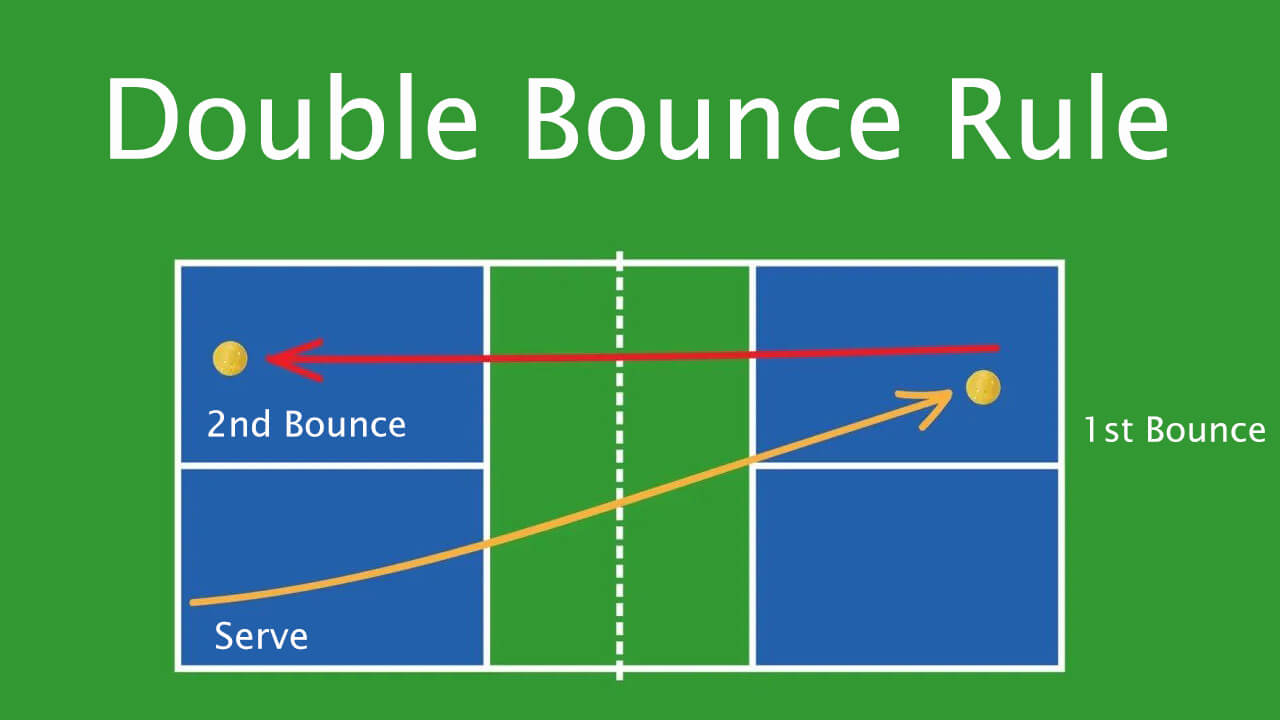Here is a complete guide about the double bounce rule in pickleball and how you can master it with a few simple tricks.
What Is The Double Bounce Rule In Pickleball?
Pickleball is a game full of thrill and excitement. However, many rules can confuse anyone new to the game, specifically regarding bounces. One such rule is the double bounce rule, which sounds like a difficult deal in theory.
Yet, with practice on the field, you can practice mastering it during every pickleball match. To help you with this, here is a complete guide about the double bounce rule in pickleball and how to master it. So, dive right in for more.
What Is The Double Bounce Rule In Pickleball?
In simple words, double bounce means the entire round of the ball, including the initial hit, the return, and the hit after that. The rule says that the ball must bounce two times during this round, once in the opponent’s area of the pickleball net before it comes back to you and the second time on your side when you serve the ball back over the net.

It means the ball has to bounce on each side (the server and the receiver), hence the double bounce rule. Pickleball is a bit different from tennis and ping-pong, as they only require the receiver to wait for the spin at least two times during the round.
What Happens When You Break The Double Bounce Rule?
Not adhering to the double bounce rule before playing a volley is considered a fault. The server gets the point if you are on the receiving end and don’t follow the two shot rule for whatever reason. In contrast, if the server cannot adhere to the rule, it loses the service, and it transfers to the opposite side.
If you stand in the non-volley zone line, it reduces the distance, and it is incredibly easy to return the ball, making it quite difficult to follow the rule.
How to Master The Double Bounce Rule?
The first thing to help you remember this pickleball rule in a single game is always standing by the baseline from the serving side. Keep your feet stable and hit the serves deeper than usual. This will give you a strategic advantage because you will feel less tempted to hit the ball immediately.
Similarly, to avoid hitting the ball immediately after return, you must stand as far back as possible in a double game. This allows you to wait patiently and resist volleying the ball back to the other side of the net.
Why Use The Double Bounce Rule?
This rule was introduced in the pickleball game, as it helped maintain the game’s pace. Without this rule, it would be too easy and quick for the receiver to return the ball, which is not fun and can get irritating at one point.
If this rule hadn’t been introduced, the receiver would have been in the kitchen line from where the server would volley the pickleball using the smash technique. Handling a high-served smash can be frustrating and dry. Also, this scenario would require you to move back and forth between the base and kitchen line, which is pretty challenging in this period.
So, having this rule helps you eliminate the serving advantage and adds to the distance between two volleys. If you are still unconvinced, try playing pickleball without this rule in the warmup session, and you will know how boring the game is.
Other Pickleball Bounce Serve Rules You Must Follow
According to the Rule State, pages number 25 and 26, here are the following bounce rules a server observed after dropping the ball and hitting the serve;
- The server is expected to release the ball from one hand and a natural height. They are not allowed to forcefully bounce the ball off the court or toss the ball. They must hit the ball once it bounces on their side.
- The server must let the ball drop off the paddle from a natural height (preferably under the belly button)
- The serving must be visible to both the receiver and the referee.
- For matches that do not have a referee, when the server releases the ball, it must be visible from the receiver’s end.
- The ball can be bounced as many times as the server wants before releasing it for the first time.
- After the referee calls the score, the server must shoot the ball within the 10 second interval.
- The service ball is free to bounce anywhere on the field surface.
Useful Pickleball Bounce Tricks To Improve Your Serve
Finally, this rule can only make sense when you know how to improve your serving technique. Here are some simple tips and tricks that can help you make your services better;
On the field, you can pickleball serve in two ways, either a drop serve or a volley serve. Both these techniques have different sets of rules, as discussed above. For beginners, volley serve is the easiest one to master. In contrast, drop service is a little technical but allows the ball to flow naturally between each round. That being said, the trick to both the serves is to let it bounce and hit it under the belly button.
How you hold your paddle also greatly matters in keeping the serve correct. This also helps the server limit its bounce while in the field, which is the biggest distraction while you are out there. Ideally, you have a neutral yet firm grip. In simple terms, always exert proper pressure that is neither too much nor too loose.
It is equally important to maintain calmness and composure, especially when you are nervous. This is because, in this situation, your body tends to stiffen up from the overwhelming anxiety in your body. To avoid this, always warm up before each game and make sure your body is relaxed. Also, keeping your legs apart from each other will help you a lot.
People Also Ask
Can You Play Pickleball Without The Double Bounce Rule?
No, you cannot play pickleball without the double bounce rule. This is because if the ball does not bounce at any side of the court, it is considered a foul, and the opposite side gets the point. Following this rule, you should let the ball bounce once on your side. Without this rule, the players don’t have enough time to switch spaces and respond to serves, making it frustrating and dry.
Is Pickleball The Only Sport With The Double Bounce Rule?
Although other games also have the double bounce rule, Pickleball has its own version of this rule, which makes it unique and a little confusing. The beauty of this rule is that it makes the game more competitive and enjoyable. As per the rule, both teams must bounce the ball in the opposition’s court. If they fail to do so, they lose a point. Generally, this rule was introduced to make the game fair and moving.
Does The Double Bounce Rule Mean The Ball Can Bounce Twice?
Well, the answer is yes. The ball should bounce once on both sides, serving and receiving ends of the pickleball court. But, you should always remember that the ball must not bounce more than once at one side of the court, as it violates the rule and gives the opposite side a point.
Are The Double Bounce And Two-Bounce Rules The Same?
Usually, most beginner players get confused between the double bounce and the two bounce rules. The double bounce rule is a law in which the ball should bounce in the receiving court from the serving court, followed by a bounce back in the serving court from the receiving court. On the other hand, the two-bounce rule is a foul that occurs when the ball bounces twice in the same court.
What Are The Tips To Remember This Rule While Playing?
The easiest and simplest way to remember this rule is to stand at a far distance while the opponent is serving the ball. This will help you to give time for the ball to bounce. But you will have to be a little faster to hit the ball. Otherwise, the opposite side will get a penalty point if the ball bounces more than once.
Who Calls A Double Bounce In Pickleball?
In pickleball, the person on whose side the ball hit twice can call a double bounce. The person who hit the ball on two bounces also can call it. It is also like an unofficial line call in pickleball.
What Are The Different Shots In Pickleball?
There are some pickleball shots and strokes that you need to master to become a pro. These include Serve, Groundstroke, Volley, Lob, Dink, Smash, Drop Shot, Drive, and Topspin and Backspin.
How Many Times Can The Ball Bounce In Pickleball?
In pickleball, the ball can only bounce once before the player or team returns it. After the serve, the player has to hit the ball to the opponent’s court. So, in pickleball, the ball can bounce once on the serving and receiving court for a total of two bounces in a single point.
Conclusion
In the end, pickleball is a great pastime and allows players to spend their leisure time while being productive. However, for beginner or recreational players, the rules of this game can be challenging. As a player, I would say the double-bounce has been such a rule for me and has taken me the longest to master.
Finally, if you are in a similar situation, I hope this guide has been helpful to you.
Other Related Posts:
- Pickleball Terms
- New Pickleball Rating System
- Best Shoes For Pickleball
- Difference Between Tennis & Pickleball
- Best Pickleball Bags

I, Jeena Noven, am a renowned pickleball expert and author with over 10 years of experience playing and coaching the sport. My passion and extensive knowledge of pickleball has made me a leading authority in the game, particularly in the field of footwear. I have written countless articles for https://pickleballcard.com/, a website dedicated to pickleball, sharing my insights and expertise on the best shoes for the sport. Through personal testing and reviewing countless different brands and styles, I have developed a deep understanding of the technical aspects of shoe design that make them suitable for the demands of pickleball. In my articles, I provide valuable information for both beginner and advanced players, covering everything from the basics of shoe fit and support, to advanced tips for maximizing performance on the court. As a dedicated pickleball player and expert in footwear, I am a valuable resource for players of all levels. My articles are not only informative but also engaging, making them a must-read for anyone looking to improve their pickleball game. I am constantly researching new products and trends in the industry and my readers can always count on me to provide the most up-to-date and accurate information on the best pickleball shoes available.
Leave a Reply